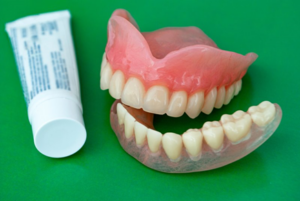Getting Your Dentures to Stick with Denture Adhesive
July 8, 2024

Though dentures are designed to fit pretty snug, it’s not uncommon for them to slip out of place from time to time, especially when they’re new. As the name suggests, denture adhesive can help your prosthetic stick in place. However, there are plenty of different types to choose from, all with different use instructions. It can get confusing pretty quick! Here’s what you need to know about using denture adhesive.
Adhesive Strips: Peel and Stick
These are thin, stretchy strips that you can apply to your dentures. They’re on the low-profile end of the spectrum, meaning they won’t add any extra bulk to your prosthetic. To use them properly, follow these steps:
- Clean your dentures and mouth with a rinse and brushing
- Dry your hands and the underside of your prosthetic
- Peel back the film cover on your strip, then place in the middle of your dentures
- Insert your dentures
- Bite down and swallow to ease them into place
- Enjoy more reliable, fixed dentures!
- Clean off any remaining residue at night
Basically, adhesive strips are kind of like Command hooks for your prosthetic.
Adhesive Powder: For Dentures, Not Shakes!
Some patients prefer powder adhesives because their suction abilities typically last longer, and they’re easier to clean off dentures at the end of the day. Like strips, they’re low-profile, but you’ll apply powder adhesive slightly differently:
- Brush and rinse your mouth and dentures
- Sprinkle the powder evenly over the underside of your prosthetic
- Shake loose any extra powder
- Insert your dentures
- Bite down, this time holding the pressure for a few seconds
- Don’t forget to scrub away lasting residue when you’re done!
Any kind of powder can get messy. To make your life a little easier, lay out a paper towel over your counter or sink.
Adhesive Cream: A Pillow for Your Dentures
Cream adhesive is an interesting option. Some might find the texture more appealing than powder or strips, and it offers a bit of cushion between your gums and prosthetic. If your mouth is feeling sensitive or tends to be sore, a cream product could be your ticket. Here’s how to use them:
- As always, brush and rinse
- Ensure your dentures are completely dry
- Squeeze the cream onto a Q-Tip or similar tool
- Run the Q-Tip along the edges of your dentures
- Insert your dentures
- Press or bite down, and voila – your cream adhesive should be set!
- You know the routine; be sure to clean off icky residue at the end of the day
Keep in mind that adhesive cream will spread to fill in the gum side of your dentures – you might notice some bulk or lift.
When NOT to Use Denture Adhesive
These useful products are meant to assist with dentures that settle well in your mouth. If you find yourself applying more and more adhesive, or enduring sores and irritation, it could be a sign your prosthetic needs an adjustment. Ill-fitting dentures can negatively impact your oral health, so it’s best to visit your dentist rather than rely on adhesive. Once your dentist resizes them to better suit your mouth, you’ll notice that they stay in place better anyway!
About the Practice
At Ellicott City Smiles Dental Group, we have an impressive roster of highly educated and skilled specialists, including a board-certified prosthodontist. That just means that Dr. Navpreet Kaur Khatra is professionally recognized for her expertise with dental restorations such as dentures. If your prosthetic is giving you persistent problems, don’t hesitate to contact us at 410-465-3224.
No Comments
No comments yet.
RSS feed for comments on this post.
Sorry, the comment form is closed at this time.
